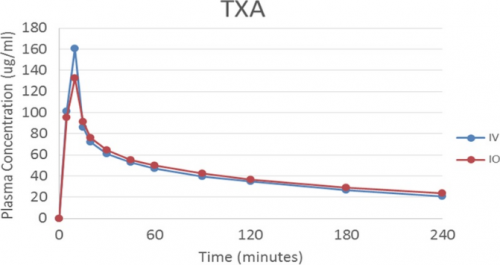The use of tranexamic acid (TXA) in trauma patients has escalated dramatically since the CRASH-2 trial was published ten years ago. It has become a frequent addition to the massive transfusion protocols used by trauma centers. And we are now even seeing TXA given by prehospital provides when life-threatening bleeding is suspected.
This drug is popular because it is inexpensive (~$100/dose) and is thought to be safe. However, some trauma professionals have been concerned about thrombotic side effects since TXA is a finbrinolysis inhibitor.
The group at the Mayo Clinic performed a retrospective study of seven years of their own data to determine if the concern for thrombotic complications was warranted. They specifically evaluated in-hospital mortality and thrombotic events up to 28 days after injury. They also scrutinized outcomes in patients who received only the bolus TXA injection, but not the infusion.
Here are the factoids:
- A total of 848 patients were included in the study, but there was no information as to what the inclusion criteria were
- Only 212 received TXA; the other 636 were considered the control group, and there were no differences in age, sex or mechanism of injury
- Thrombotic events occurred in 13% of the TXA patients and only 6% in the control group, which was statistically significant
- Specific thrombotic events in TXA vs non-TXA patients: DVT was 8.5% vs 3.5% (significant), pulmonary embolism was 3.8% vs 1.9% (NS), MI was 1.9 vs 0.4% (NS), stroke was 2.4% vs 1.1% (NS)
- Thrombotic events occurred more frequently in patients who received both doses of TXA (23%) vs just the bolus (10%), and this was also significant
- In-hospital mortality was 21% with TXA vs 10%, which was not significantly different, controlling for confounders
The authors concluded that TXA administration was associated with higher rates of thrombotic events. They went on to state that TXA should not be routinely given for trauma patients in the community setting.
Here are my comments:
This is a bold recommendation from this very small study. The CRASH-2 trial was randomized and placebo controlled, and analyzed their experience with 10,000 subjects in each arm. This retrospective study has only 212 TXA vs 636 control patients. Big difference.
The authors attempt to match the TXA patients with controls. They controlled for age, sex, mechanism, and ISS. But it does not appear that there was any control for injuries known to increase the risk of thrombotic events like spine and pelvic fractures.
And why look at a full 28 day interval for thrombotic events? I would expect most of these events to occur in the first few days. Including an entire month in the study allows thrombotic events from other causes to creep in.
Here are some questions for the presenter and authors:
- Please comment on how the small numbers in your study may have an impact on the results.
- What were the selection criteria for your 848 patients? Were they all of your trauma activation patients? If not, is there some selection bias possible?
- DVT appears to be the driver for your “significant” number of thrombotic events. Yet the other events (MI, stroke, PE) were not significantly different. This seems counter-intuitive, since the DVT numbers themselves numbered only about 20 in each group. Please describe the statistics you used to derive this conclusion.
- Did you look at the incidence of injuries that are known to increase the risk of thrombotic events in the two groups? If there was an excess of pelvic or spine fractures in the TXA group, this might not be picked up in your analyses and could skew your data.
- Why did you include thrombotic events for a full 28 days after injury? This allows for later events caused by factors other than the TXA. Show us a redo of your analysis using 5 or 7 day thrombotic events.
These are interesting numbers, but I have to admit that I am skeptical. I’m not clear how community hospital administration of TXA makes it more likely associated with thrombotic events. I will definitely be listening intently to this presentation. And probably asking these questions.
Reference: Risk of thromboembolic events after the use of TXA in trauma patients. AAST 2020, Oral Abstract #15.

